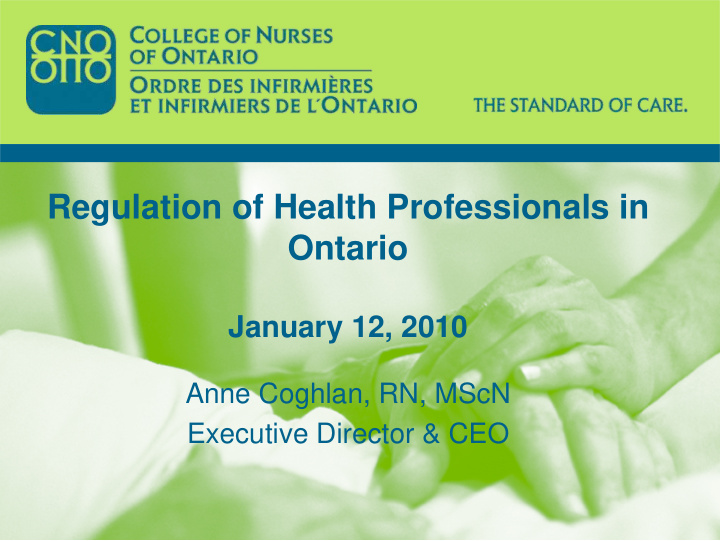



Regulation of Health Professionals in Ontario January 12, 2010 Anne Coghlan, RN, MScN Executive Director & CEO
Self-Governing Health Professions � Audiology & Speech � Kinesiology * � Opticianry Language Pathology � Chiropody � Massage Therapy � Optometry � Chiropractic � Medical Laboratory Technology � Pharmacy � Dental Hygiene � Medical Radiation Technology � Physiotherapy � Dental Technology � Medicine � Psychology � Dentistry � Midwifery � Psychotherapy * � Denturism � Naturopathy * � Respiratory Therapy � Dietetics � Nursing � Traditional Chinese Medicine * � Homeopathy * � Occupational Therapy
The Regulated Health Professions Act 1991 (RHPA) � Umbrella legislation for all health professions � Health Professions Procedural Code – applies equally to all regulated health professions � Profession-specific Acts – describe the scope of practice and any controlled acts authorized to a profession � 13 “controlled” acts – soon to be 14 Administered by the Ministry of Health and Long � Term Care (MOHLTC)
Purpose of Health Professional Regulation The RHPA and health profession Acts provide a common framework for Ontario’s regulated health professions, incorporating a number of underlying principles, including: � As a primary principle, advancing the public interest � Protecting the public from harm and unqualified, incompetent or unfit providers � Promoting high quality health care services and accountability of health care professionals � Providing patients/clients access to health care professionals of their choice
Purpose of Health Regulation cont’d � Achieving equality and consistency by requiring all regulated health professions to adhere to the same purposes, objects, duties, procedures and public interest principles � Treating individual patients/clients and health professionals in an equitable manner � Providing flexibility in roles of individual professions and room for evolution of professions through broad scopes of practice provisions
Scope of Practice A general statement in the health profession Act describing in broad terms what the profession does and the methods it uses.
Controlled Acts � 14 controlled activities that may put the public at substantial risk � Authorized to be performed by certain regulated health professions in the course of providing health care services 14 th controlled act (psychotherapy) added in June � 2007, but not yet in force
Controlled Acts Communicating diagnosis Prescribing, dispensing, selling or � � compounding a drug � Procedures on tissue below the dermis � Vision care Setting a fracture or a dislocation Hearing care � � � Moving joints of the spine beyond � Dental care usual range Managing labour � Injection/inhalation � � Allergy testing � Inserting an instrument, hand or Psychotherapy � finger Applying/ordering a form of � energy
Regulatory Changes to Support Inter-Professional Practice New Objects Added as of June 2007: � To promote and enhance relations between the College and its members, other health profession colleges, key stakeholders and the public � To promote inter-professional collaboration with other health profession colleges � To develop, establish, and maintain standards and programs to promote the ability of members to respond to changes in practice environments, advances in technology and other emerging issues
Recommend
More recommend